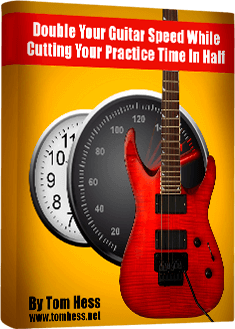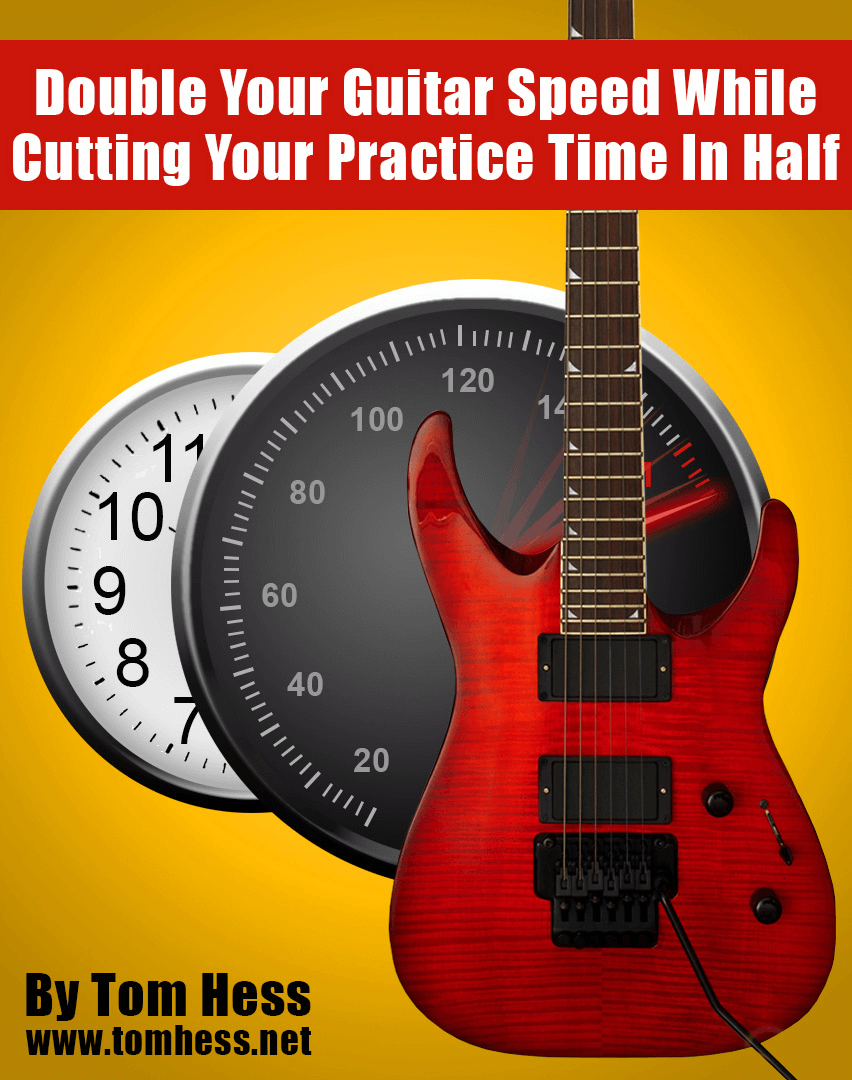Building Guitar Speed – Do This To Play Guitar Faster Now
BY AT LEAST 100%

EMAIL TO GET ACCESS
By submitting your info, you agree to send it to Tom Hess Music Corporation who will process and use it according to their privacy policy.
In this guitar practice article...
... I show you how to build guitar speed and play guitar faster...
... without moving your picking hand (or your fretting hand) any faster than they already do...
... and without increasing your guitar practice time.
All you have to do is:
1. Make a few (simple) changes to how you practice guitar, and...
2. Practice the exercises I’ll show you in this guitar speed video and article.
When you do...
... your current guitar speed licks will feel much easier to play fast, and (most importantly) ...
... you’ll play guitar faster without sloppy mistakes or feeling your hands get tired, or tension building in your body.
BY AT LEAST 100%

EMAIL TO GET ACCESS
By submitting your info, you agree to send it to Tom Hess Music Corporation who will process and use it according to their privacy policy.
To begin...
Watch this video that shows you how play guitar faster without moving your hands faster than they do right now:
Now that you know the basics of guitar practice for building guitar speed, let’s go deeper.
Here are 5 more proven strategies to use when you practice guitar that’ll help you play guitar fast (without moving your hands faster):
Guitar Practice Tip #1 For Building Guitar Speed: Make Your Guitar Technique More Efficient
Most guitar players try to build guitar speed by forcing their hands to move faster.
Big mistake.
If you want to play guitar fast, the first thing to fix is inefficiency.
Because inefficient guitar technique slows you down, tires your hands quickly and makes it much harder to build guitar speed over time.
So, how do you make your guitar technique more efficient?
You begin by removing two of the biggest sources of wasted motion:
- Inefficient picking technique
- Flailing fingers in your fretting hand
Let’s look at both, starting with your picking hand.
The most efficient picking technique is directional picking.
This means: when you play notes on the same string, you use alternate picking (down-up-down-up). But when you move to a new string, you follow the direction your pick is already going.
If you’re changing to the higher (in pitch) string, you begin playing the higher string with a downstroke.
If you’re changing to a lower (in pitch) string, you begin playing the lower string with an upstroke.
That’s it.
This small change reduces how far your pick has to move for every note. Over time, this makes it much easier to play guitar fast, because you are moving your picking hand the shortest distance possible.
Watch this video to see how to practice directional picking the right way:
Question: "But Tom Hess, isn’t directional picking just economy picking with a new name?"
Answer: No, directional picking is not the same as economy picking. Economy picking requires you to sweep pick on every string change (or else – you have to change the lick you’re playing to be compatible with economy picking).
With directional picking, you're not restricted to sweep picking on every string change like economy pickers are. You use the most direct path to the next string. This ‘sometimes’ allows you to sweep pick through ‘some’ string changes... so you do that, without having to hop over strings, as you would with strict alternate picking.

Now look at your fretting hand.
One of the biggest causes of slow and sloppy playing is flailing fingers - fingers that fly far away from the fretboard after they play a note.
This creates a lot of tension and wastes precious milliseconds each time you fret a note.
How to fix flailing fingers?
Watch this video that shows you what to do step by step:
Follow these tips and you’ll be shocked how much cleaner and easier your guitar playing becomes... without moving your hands any faster.
Guitar Practice Tip #2 For Building Guitar Speed: Train Your 2-Hand Synchronization
You can’t build guitar speed if your hands are out of sync.
Even if your picking hand is fast... even if your fretting hand is fast...
...you won’t play guitar fast in real music until both hands mesh together like teeth of a gear.
And here is the big mistake guitarists make as they’re building guitar speed:
The mistake many guitarists make as they’re building guitar speed is: trying to max out their top speed first and then working on their 2-hand synchronization second.
But this only leads to your notes sounding sloppy, rushed, or uneven. No amount of raw speed can fix that.
Watch this video to see an example of this and how to practice to fix it:
And here are some of my favorite guitar practice drills to work on 2-hand synchronization that help to build guitar speed and clean up your technique as you practice guitar:
- Play with a metronome and find the fastest metronome tempo where you can lock the first note of each grouping of notes perfectly with the click (the first note of every group of 4 if playing 16th notes or the first note of every group of 6 if playing sextuplets).
- Find your sync threshold - the exact tempo where your hands start to fall out of alignment.
- Back off by 5-15 bpm and practice just below that threshold. This is your sweet spot for building guitar speed.
- Double pick each note to exaggerate the difficulty. This forces your hands to work together more precisely.
- Focus on the feeling of the string slapping against the fretting hand finger. This is your main indicator of tight 2-hand synchronization.
- Create a single-string variation of your guitar lick. This makes it harder to keep the hands in sync than it would be if there were string changes (where you can reset the hand synchronization on each new string).
- Isolate your hands. Rest your fretting hand lightly on the strings and do the picking motion only. Then do the opposite. As you refine your motions of each hand, your synchronization with both hands will improve.
Pro tip: practice guitar unplugged sometimes. If you can still hear your notes clearly and evenly without an amp, that’s a good sign your hands are working together well.
Guitar Practice Tip #3 For Building Guitar Speed: Control Excess Muscle Tension
If your hands feel tight or your body tenses up when you try to play guitar fast, it means you’re encountering the silent killer of guitar speed:
Excess muscle tension.
Tension makes your hands move slower, it tires you out faster, and it causes mistakes you wouldn’t make at slower tempos.
The good news?
You can train yourself to stay relaxed while playing fast - and that’s when your guitar technique really takes off.
Here’s how to do it:
Step 1: Start with a “tension audit.”
As you play, mentally scan through your body and relax any areas that feel tight.
Start with your jaw and neck, then check your shoulders, arms, stomach, and even your legs and feet.
You’ll be surprised how much tension builds up in places that have nothing to do with your hands.
This guitar practice video shows you how to a tension audit as you’re building guitar speed. Follow the steps in it as you practice guitar.
Step 2: Rotate your focus during your guitar practice.
Don’t try to relax everything all at once.
Focus on one area at a time.
For example: Spend one minute relaxing your jaw. Then switch to your picking hand grip. Then your shoulders. This is called focus rotation, and it makes the process much easier and more effective.
Watch this video to see an in-depth demonstration of focus rotation:
Step 3: Exhale before you play.
A lot of tension builds up because guitar players hold their breath without realizing it.
Try this: right before playing a fast lick, simply exhale fully.
This naturally lowers your overall tension level and helps your body stay loose as you play fast guitar licks.
Step 4: Don’t over-grip the pick.
One of the biggest sources of tension is holding the pick too tightly. You want just enough pressure to control the pick and get a strong attack - but not more than that.
Watch this video to see how I recommend to hold the guitar pick when building guitar speed:
Step 5: Practice in short bursts.
If you play the same fast lick for too long, your muscles start to tighten. That’s normal. But it also means you’re no longer building guitar speed - you’re just training your body to fight itself.
Instead, practice fast licks for 10–20 seconds, then stop and reset. Stretch, breathe, relax, and start again.
The more you use these tips while you practice guitar, the easier it becomes to build guitar speed and have your fast playing feel effortless.
Guitar Practice Tip #4 For Building Guitar Speed: Use Speed Bursts
Want a fast way to break through speed plateaus?
Use speed bursts.
Speed bursts are short (4-12 note-long) fragments that train your hands and brain to handle higher speeds without falling apart.
Instead of trying to play an entire lick fast from start to finish, you play just a small part of it at a speed that feels slightly out of your comfort zone. Then you pause, relax and repeat... until the fragment is clean.
Here’s how to do it:
Step 1: Choose a short lick.
Keep it between 4 and 12 notes. You want something small enough to play fast, but still challenging enough to push your limits.
Step 2: Set your metronome above your current top speed.
Try going 10 to 15 bpm faster than the speed where you normally feel comfortable. You don’t need to stay there long - just enough to trigger a challenge.
Step 3: Play the burst once, then stop.
Play the burst once, then take a few seconds to rest. Let your hands relax completely. Analyze what you played and confirm (in your mind) if the notes were fully clean or not.
Step 4: Repeat step 3 several times.
Aim for 3 to 5 good reps, focusing on cleanliness and relaxation. If you start to feel sloppy or tense, reduce the tempo slightly or shorten the lick even more.
Step 5: Gradually add more notes.
Once the burst feels easy, add one or two notes to the end. Keep practicing at the same tempo. Eventually, you’ll be able to play the full lick at that higher speed.
Watch this video to see how to use speed bursts as you practice guitar:
Guitar Practice Tip #5 For Building Guitar Speed: Combine Guitar Techniques Together
To make your guitar speed usable in real life, you need to learn to play guitar fast with multiple techniques that integrated together seamlessly.
Here is a simple guitar practice process for combining guitar techniques that will help you play guitar fast:
Step 1: Choose 2 guitar licks (or techniques) you want to combine together smoothly as you practice guitar.
Step 2: Isolate the last 3-4 notes of technique 1 and the first 3-4 notes of technique 2.
Step 3: Practice the isolated section until you can play it smoothly and cleanly.
Step 4: Once the transition part feels easy to play, playing through both techniques will feel easy.
Watch this video to see how to apply these guitar practice tips to combining scales and arpeggios as you build guitar speed:
Now that you know how to build guitar speed (without moving your hands faster), I want to show you more simple guitar practice tricks that can help you double your guitar speed, cutting the amount of time you spend practicing guitar in half. I show you how in this free guitar speed eGuide. Download it today and discover the guitar speed secrets most guitarists will never know.


Improve your guitar playing fast by taking lessons with a proven online rock guitar teacher.

